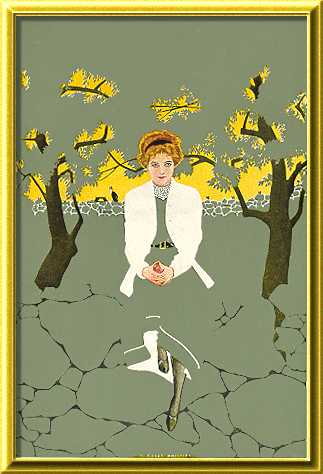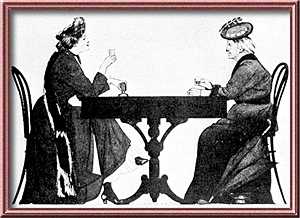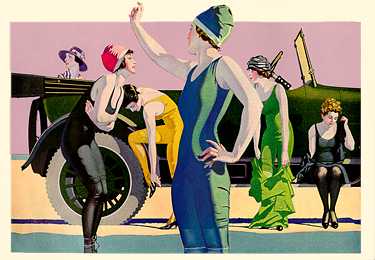


 |
See Coles Phillips in #s 3 & 9 of
|

The Siege of the Seven Suitors - 1910
C. Coles Phillips was born in 1880 in Springfield, Ohio. Others of his generation include Joseph Clement Coll, Edmund Dulac, Harvey Dunn, Walter Everett, Willy Pogany, Harry Rountree, Sarah Stilwell Weber, and N.C. Wyeth, Though he enjoyed drawing as a youngster, when he graduated from high school his father got him a job as a clerk for the local American Radiator Company.
 By
all accounts Phillips was a personable, attractive young man and
really had no interest, or talent, for clerking. He enrolled in
Kenyon College in 1902 and found an audience for his art in the
school year books. His drawings appear in the 1901-1904 issues
of The Reveille. After his Junior year, he had enough.
He really wanted to draw and in 1904 left Ohio for New York City
determined to earn a living with his art.
By
all accounts Phillips was a personable, attractive young man and
really had no interest, or talent, for clerking. He enrolled in
Kenyon College in 1902 and found an audience for his art in the
school year books. His drawings appear in the 1901-1904 issues
of The Reveille. After his Junior year, he had enough.
He really wanted to draw and in 1904 left Ohio for New York City
determined to earn a living with his art.
Of course, Phillips, being a practical sort, brought along a letter of recommendation from his boss at American and quickly got a job at their New York office. His winning ways soon rescued him from clerking and he rose to the only slightly better position of salesman. An unflattering caricature of the company's president cut short that career after only a few months.
The incident led to an amazing coincidence, of a magnitude
that only occur in legend. The co-worker, for whom Phillips has
done the drawing was dining that very evening with J.A. Mitchell,
the publisher of Life Magazine, a popular humor magazine
in its first incarnation. Upon hearing the sad tale of dismissal,
he asked to see the offending drawing, liked it, and asked that
Phillips come by and see him. Mitchell just might have a place
for him at Life. Surely Phillips was aware of the opening
that had magically appeared before him and it's odd that he failed
to take advantage of it. He never went to the interview and instead
enrolled in art classes - perhaps to become worthy of the honor
Mitchell had offered.

He lasted three months at the art school. Advertising positions followed, including his own agency for a year. Finally in 1907 he decided it was time to take Mitchell up on his offer. Blustering his way into a meeting, he presented Mitchell with his one image, carefully crafted to match the Life style. It was the image above of beauty raising a glass to age. It got him the job. At the age of 26, Coles Phillips had arrived and the association with the magazine would endure throughout his life.
 He
quickly became popular with the readers and was soon awarded cover
assignments. The following year, in 1908, Phillips created a cover
that would become his trademark. By combining foreground and background
elements of the same color, he created the "fadeaway girl".
There's a 1910 example at the top of the page from The Siege
of the Seven Suitors, a book by Meredith Nicholson, and another
above right from 1908 - one of four illustrations he did for Gertrude
Atherton's book, The Gorgeous Isle. It's a testament to
both the novelty and the creativity of the style that he was using
it for Life covers and book illustrations within months
of its inception. The first Life appearance was in May,
and the Atherton book was dated October, both in 1908. By the
end of the year, a mere 15 months after his first work appeared,
Phillips was a star in same firmament as Charles Dana Gibson and
James Montgomery
Flagg.
He
quickly became popular with the readers and was soon awarded cover
assignments. The following year, in 1908, Phillips created a cover
that would become his trademark. By combining foreground and background
elements of the same color, he created the "fadeaway girl".
There's a 1910 example at the top of the page from The Siege
of the Seven Suitors, a book by Meredith Nicholson, and another
above right from 1908 - one of four illustrations he did for Gertrude
Atherton's book, The Gorgeous Isle. It's a testament to
both the novelty and the creativity of the style that he was using
it for Life covers and book illustrations within months
of its inception. The first Life appearance was in May,
and the Atherton book was dated October, both in 1908. By the
end of the year, a mere 15 months after his first work appeared,
Phillips was a star in same firmament as Charles Dana Gibson and
James Montgomery
Flagg.
A typical Life cover (this from 1911) is at left. One element not often mentioned is that on many of his cover paintings, the novelty of the technique and the striking design qualities masked the fact that Life was getting by with single color or two-color covers in a day when full-color covers were de rigueur for the better magazines. So not only did Mitchell's circulation go up due to the Phillips covers, his printing costs went down!


Just as there was a "Gibson Girl" of the turn of the century, there was a "Phillips Girl" in the teens and twenties. She showed a lot more skin than her older sister, but she still had a wholesome look to her. Her images were collected in 1911 from the pages of Life and Good Housekeeping into A Gallery Of Girls by Coles Phillips. A year later A Young Man's Fancy with more of his paintings appeared. As the years passed, and the times changed, the decorum so prevalent prior to the war gave way to an overt sensuality. You can see it in the 1917 and 1918 ads for Luxite Hosiery and Overland Auto above. Phillips poses combined just the right amount of titillation with just the proper degree of unconsciousness about it. His women may have been sexy, but they didn't know you were looking.

 The
one thing they most definitely were was a roaring success. From
the beginning, even before the fadeaway technique made them megastars,
Phillips paintings of women were something special. I think it
was because he was the most effective at moving them from the
Edwardian age into the Roaring Twenties. He was capable of much more
as these bracketing figures, from the 1921 and 1922 Naval Yearbook,
The Lucky Bag, attest. The frank gaze of the girl in the
Navy jacket is simply captivating.
The
one thing they most definitely were was a roaring success. From
the beginning, even before the fadeaway technique made them megastars,
Phillips paintings of women were something special. I think it
was because he was the most effective at moving them from the
Edwardian age into the Roaring Twenties. He was capable of much more
as these bracketing figures, from the 1921 and 1922 Naval Yearbook,
The Lucky Bag, attest. The frank gaze of the girl in the
Navy jacket is simply captivating.
It's unfair to think of Phillips as a "one-trick pony" just as it's wrong to downplay the fadeaway technique as merely a contrivance. In the midst of an era of magazine covers by Mucha and Parrish and some of the greatest names in illustration history, Coles Phillips came up with a new idea that worked. Not only that, but he was able to bring his strong design sense and his natural ability for painting into play to create hundreds of excellent paintings around that design element.
At the time of his death in 1927, he was preparing for the next stage of his career. It's our loss that we'll never know what that would have been.
C. Coles Phillips was inducted into the Society of Illustrators Hall of Fame in 1993. To learn more about Coles Phillips, see:
To learn more about Coles Phillips, see:| "All-American Girl" The Art of Coles Phillips | Michael Schau, Watson-Guptill 1975 |
| The Illustrator in America 1880-1980 | Walt and Roger Reed, Madison Square Press 1984 |
| Famous American Illustrators | Arpi Ermoyan, Society of Illustrators 1997 |
| The Vadeboncoeur Collection of Knowledge | Jim Vadeboncoeur, Jr. 1999 |
| The Vadeboncoeur Collection of ImageS 3, 9 | Jim Vadeboncoeur, Jr. JVJ Publishing 2002, 2009 |
|
Illustrations are copyright by their
respective owners. This page written, designed & © 1998 by Jim Vadeboncoeur, Jr. Updated 2011. |
